(Continued from Part 1. This concludes the two-part series.)
The Straight Stack
I initially stacked my split wood in straight, eight-foot sections about four feet high. This made each of those sections contain approximately a face cord of wood. Three face cords comprise a full cord. We typically burn six to eight full cords each winter.
I put a strip of tarp on the top of each stack and weighted it down with extra pieces of wood. This kept the rain off the top of the stack while allowing the wind to blow through and the sun to dry the sides.
One problem with straight stacks is that as wood dries, it shrinks. This may make a straight stack shift and become unstable as the drying process progresses. It was not unusual for a stack to fall over and need to be re-stacked, especially around the time of Halloween each year.
The Round Stack
 Several years ago on my birthday, my daughter gave me the book Norwegian Wood by Lars Mytting. This delightful book talks about “chopping, stacking, and drying wood the Scandinavian way”. One topic touched upon in the book is round wood stacks. I was inspired to try my own version of the round stack. Since I wanted the stack to be especially stable, I began with a ten foot long wooden piling sunk three feet into the ground. I then built a round wooden base around the piling. The starting point for this base is eight 37-inch 2X2’s laid out as an octagon centered on the piling.
Several years ago on my birthday, my daughter gave me the book Norwegian Wood by Lars Mytting. This delightful book talks about “chopping, stacking, and drying wood the Scandinavian way”. One topic touched upon in the book is round wood stacks. I was inspired to try my own version of the round stack. Since I wanted the stack to be especially stable, I began with a ten foot long wooden piling sunk three feet into the ground. I then built a round wooden base around the piling. The starting point for this base is eight 37-inch 2X2’s laid out as an octagon centered on the piling.
I then built up the bases using a variety of salvaged materials. For my most recent bases, I had a number of treated 2X6’s that I had salvaged from a wooden walkway. Because they were treated, they were not safe to burn, and I was not eager to place them in a landfill. Instead I re-purposed them, first as supports to run between the sides of the octagon.
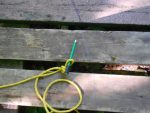 I then used the rest of the 2X6’s to run perpendicularly over the supporting 2X6’s, and fastened them down with deck screws. I used pieces of 2X2 as temporary spacers while I was placing and fastening down the upper 2X6’s. Next, I tied a loop in one end of a rope and placed it over the piling. I then tied a second loop in the other end of the rope just beyond the most distant corner of the octagon. After placing a pencil in the second loop, I drew a circle on the upper level of 2X6’s.
I then used the rest of the 2X6’s to run perpendicularly over the supporting 2X6’s, and fastened them down with deck screws. I used pieces of 2X2 as temporary spacers while I was placing and fastening down the upper 2X6’s. Next, I tied a loop in one end of a rope and placed it over the piling. I then tied a second loop in the other end of the rope just beyond the most distant corner of the octagon. After placing a pencil in the second loop, I drew a circle on the upper level of 2X6’s.
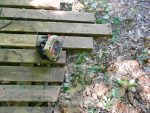 Then I took a circular saw and cut a straight line that approximated the curve drawn on each piece of 2X6. When the 2X6 base is ready, I begin to stack wood around the outside edge of the base. As the stack around the outside edge become higher, I begin to fill in the middle with oddly shaped pieces. As it becomes necessary, I supplement by filling with more regularly shaped pieces.
Then I took a circular saw and cut a straight line that approximated the curve drawn on each piece of 2X6. When the 2X6 base is ready, I begin to stack wood around the outside edge of the base. As the stack around the outside edge become higher, I begin to fill in the middle with oddly shaped pieces. As it becomes necessary, I supplement by filling with more regularly shaped pieces.
Since the circumference of the circle is greater at the perimeter than it is 16 inches in from the perimeter, the wood tends to naturally slope toward the outside. When this slope becomes too pronounced, I reduce it by propping up the outside edge with extra pieces of wood running along the edge. When the stack becomes about chest high, I begin stacking each subsequent row closer to the middle, until it touches the piling at the seven foot level.
The round stacks have been much more stable than the straight stacks. Because the wood tends to slope toward the outside of the stack, the round stacks naturally shed rainwater. The wood from my initial tests has dried adequately, and has burned well.
The Three and a Half Pound Axe
A few years ago, my wife and I vacationed in a log cabin that was equipped with a fireplace but not an axe. We bought a three and a half pound axe at a Walmart to split our wood while we were there. I hoped that upon returning home, the axe might replace the four and a half pound splitting maul while being free of the flawed handle design that plagues that maul. That hope was disappointed. The axe is adequate for vacation use, but it does not split as well as either my father-in-law’s splitting axe or the four and a half pound splitting maul.
The Double-Bitted Axe
A couple of years ago my daughter, who delights in encouraging my wood splitting mania, gave me a double bitted axe for my birthday. Because the faces of the bits are not particularly convex, I did not expect the axe to work as well as my father-in-law’s splitting axe. I was wrong. Even though it was designed for felling, the double-bitted axe splits small wood rounds like a hot knife through butter. It quickly became my primary wood splitting tool.
The Impact Manual Log Splitter
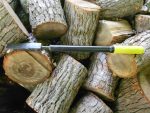 By this time, experimenting with wood splitting tools had become a bit of a hobby (some might say an obsession, but that would be uncharitable). I decided to try an impact manual log splitter. It works by driving a heavy handle down a shaft onto a captive wedge. It is even noisier than the sledge and wedge, and hearing protection is a must. Also like the sledge and wedge, I question whether any piece that requires the use of this tool is worth the effort.
By this time, experimenting with wood splitting tools had become a bit of a hobby (some might say an obsession, but that would be uncharitable). I decided to try an impact manual log splitter. It works by driving a heavy handle down a shaft onto a captive wedge. It is even noisier than the sledge and wedge, and hearing protection is a must. Also like the sledge and wedge, I question whether any piece that requires the use of this tool is worth the effort.
The Hydraulic Manual Log Splitter
 My wife found a hydraulic manual log splitter inexpensively on Craigslist, so we gave it a try. The hydraulic splitter proved to be an extremely slow but effective way of splitting difficult billets. We have found that the seals on the hydraulic pump do not hold up very well. They fail under pressure like an unprepared student taking an algebra test. Like the sledge and wedge and like the impact manual log splitter, I question whether any billet that is so difficult as to require the use of this tool is worth the effort.
My wife found a hydraulic manual log splitter inexpensively on Craigslist, so we gave it a try. The hydraulic splitter proved to be an extremely slow but effective way of splitting difficult billets. We have found that the seals on the hydraulic pump do not hold up very well. They fail under pressure like an unprepared student taking an algebra test. Like the sledge and wedge and like the impact manual log splitter, I question whether any billet that is so difficult as to require the use of this tool is worth the effort.
Reading the Wood
One of the key skills and fun challenges of splitting is reading the wood. Pieces with consistently straight grain are easy to split. Pieces with multiple Y’s or other complex patterns in the grain can be challenging, and a correct reading of the wood becomes helpful. For example, it is usually difficult to split between the arms of a Y within the grain. It is usually somewhat easier to split from the center of the top of one arm to the center of the top of the connecting arm.
With large billets of wood it is usually best to split a series of pieces off the sides of the billet, working your way around the outside of the billet. In this way you gradually make your way in toward the center of the billet, until finally the remaining billet is small enough to be split in two.
Wood Splitting as Golf
With practice, wood splitting became somewhat like playing golf. In this game, my tools were like the various clubs. I would assess a billet and select the appropriate tool for the next split just as one might assess the lay of a ball on the course and select the appropriate club. My three most-used tools were initially my father-in-law’s axe, the four and a half pound maul, and the eight pound maul. Eventually the double-bitted axe replaced my father-in-law’s axe as one of my three most-used tools. The object of “wood splitting golf” is to split each piece off the billet with the fewest possible strokes of the appropriate tool, just as the goal of golf is to place the ball in each hole with the fewest possible strokes of the appropriate club.
The Fiskars 36 Inch Splitting Axe
Eventually, a friend shares my wood splitting mania gave me a Fiskars 36-inch splitting axe as a birthday present. I cannot say enough good things about this outstanding tool. Like my father-in-law’s axe or the double-bitted axe, it is light enough to swing for extended periods of time without excessive fatigue. Like the four and a half pound maul or the eight pound maul, it can handle difficult splits that other axes cannot handle. Now, instead of playing “wood splitting golf” by selecting a tool for each split, I just use the Fiskars splitting axe for virtually all of my splitting. If the Fiskars axe cannot split a billet, I usually just use it to fuel my outdoor fire pit.
The Fiskars splitting axe comes with a lifetime warranty, but it is durable as well as effective. It does not look like I will need to avail myself of the warranty any time soon.
The Fiskars Eight Pound Splitting Maul
 The same friend who gave me the Fiskars splitting axe later gave me the Fiskars eight pound splitting maul. It is heavy and tiring to use, but very well-made. This maul is superior to my previous eight pound maul, but I use it very little. As I mentioned previously in this article, if the Fiskars splitting axe can’t split a billet, then I no longer usually bother to split it.
The same friend who gave me the Fiskars splitting axe later gave me the Fiskars eight pound splitting maul. It is heavy and tiring to use, but very well-made. This maul is superior to my previous eight pound maul, but I use it very little. As I mentioned previously in this article, if the Fiskars splitting axe can’t split a billet, then I no longer usually bother to split it.
Gasoline Powered Hydraulic Wood Splitters
I have used, but do not own, a gasoline powered hydraulic wood splitter. Although they may be useful for especially difficult billets, they are extremely loud and somewhat slow. I can split a typical billet much faster manually than I can using a powered hydraulic splitter. In view of its limitations, I have not yet considered a powered splitter to be a worthwhile investment (although if someone offered me a really good deal on a used one, I don’t think I would say “No”. Please see the words “mania” and “obsession”, above.)
Disclaimer
I have mentioned a number of products in this article. I did not receive any financial or other inducement from any manufacturer, vendor, or supplier in return for mentioning these products. This is a simple factual account of my own experiences: good, bad or indifferent.
Editor’s Closing Note: This article provides a good introduction to the subject. There are a few safety issues that I’d like to re-emphasize: Always wear eye protection when working with wood. I do not recommend using a double-bitted axe for wood splitting. The exposed rearward-facing axe head creates too many risks of injury. Also, be sure to regularly grind off any part of a splitting wedge that has mushroomed. (If a piece flies off, it can be “a formidable projectile.”) Lastly, to extend the life of your axe, maul, and sledgehammer handles, be sure to install rubber bumpers. These are inexpensive insurance.

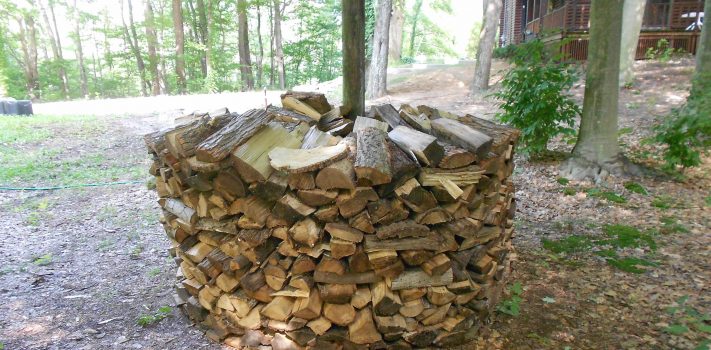









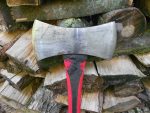
Great article(s) – one other safety thing we do (work for a tree company, logging in winter, split about 20 bush cord per year, all by hand) is sort of an ‘air squat’ as I drop the axe.
This adds a bit of power, and reduces the chance of a glancing blow getting you in the leg. THIS is very important ( a low splitting block also helps)- I’ve seen an axe take a good slice out of a leg while in a tree planting camp…
Oh, and do your splitting in the winter. The book Norwegian Wood is a great resource!
This was an excellent article. I wish I had read it decades ago.
If I could add just one more safety tip for old coots like me using gas-powered wood splitters. Like the author says, these machines are slow. The job goes faster if two people work together. However, this method greatly increases the risk of severe hand injury. When loading, grip each round on its SIDES ONLY, never on its ends.
Finally ! Someone who likes to split wood. I got my first axe when I was 4 years old, It was more like a long handled hatchet but it fit me perfectly. My Dad would toss the really straight grained billets into a pile for me to split into kindling, and I felt like a “grown up”. So my love of splitting was born. Last fall I split about 3 full cords, my neighbors thought I was crazy, and kept asking me if I wanted to use their gasoline wood splitter. I use splitting and stacking wood as my “get into the best shape I can before winter sets in” exercise. I guess some people might think it’s too much for a 61 year old woman to do, but as they say “Use it, or lose it”. Great article.
P.S. I have 5 cord coming for this year.
Subject that warms my heart at least twice!
Great safety comments.
The “air squat” would keep the ax or maul handle parallel with the ground lessening the possibility of that head glancing back into your leg. An ax will cut you, a maul can break a bone.
Montana Guy is right! I have a friend who lost a finger to a power splitter. Easier does not mean let your guard down. I want one of those machines but I am still researching.
Follow the JWR # 1 rule of wood cutting, all of your safety equipment everytime. Don’t take a risk just to make a “quick cut/ split or two”.
One of my most important safety rules is to listen to your body. Most of my close calls (near misses in a past life) have come when I was fatigued. When you are tired you lose focus. Don’t rush, get into a rhythm and use the proper technique everytime. Stop to smell the cedar every now and then.
I have always wanted to try the Norwegian wood pile. I am 64 but I can still learn new things. That is why I hang out here. God bless.
The “listen to your body rule” is vital. I think it is even more important when using a chainsaw. Thank you for mentioning it.
Completely off topic: The Star Trek reference was wonderful. Spock, speaking of the crude diamonds Kirk was going to blast from a bamboo cannon at the lizard monster stalking him.
“Impelled with sufficient force, they would make formidable projectiles.”
It was an adaptation of the classic Frederick Brown story “Arena.” Great stuff. Half a century later this old show still echos in our culture.
I have found that the sledge/ wedge combo can be effective for small-framed people. For example, I have a friend, single-mother, that was having trouble splitting small amounts of wood for her fireplace (she had been given some rounds from a neighbors felled tree). I set her up with a sledge/wedge, now all she has to do is hit the wedge until the the round splits into more manageable chunks. It’s not fast, but like a river carving a gorge she gets there eventually.
I have split hundreds of cord by hand but as I get older it is harder. I can still split faster by hand but a lot longer with a tractor mounted splitter
We bought a log splitter from Northern Tool during a sale. Very happy with it; it requires filling with hydraulic oil on delivery since the tank arrives empty for shipping reasons. 22 Ton, around $1000. Totally agree that is slower in many cases than manual (because the logs need to be positioned twice, one of the splitter sled and then carefully maneuvered during the hydraulic cycle of the split). That being said, it does allow me to help my husband and take care of some logs whilst he is working on the manual splitting and we can done faster.
Congrats to your fierce spirit and words of wisdom in the article.
I once had some sycamore that I cut for a friend. It was pretty stringy, and I had too much of it to burn in the fire pit. I finally borrowed a gas powered splitter from a friend. I wouldn’t mind having one of my own for that type of situation if I could find one cheap.
There’s an axe called the Chopper1. It splits wood well, no matter what diameter. It has 2 small opposing wedges integrated in the axe head that helps split the wood, when the axe blade enters the top of the wood. My son split an entire cord of wood in a day.
I help my friend split and cut wood all the time using either his gas powered splitter or my 3pt mounted log splitter on the back of my tractor. These are invaluable to us because we are working with anywhere from 24″ to 36″ plus maple. Have you ever tried to split maple that size by hand? There is a local tree service that will let you have all the free wood you can cut and sit as well provided you give them 50% of the cut split wood. One can’t beat free wood!
Hi Jeff,
Thanks for your question. I have often split 24″ to 36″ maple billets by hand. It is not so much a question of size, but of grain.
A large, straight-grained billet of maple, oak or ash is a joy to split. You begin by reading the wood, choosing the side of the billet which appears to have the straightest grain. You then strike the billet about 3″ in from the edge, splitting a slab off the side. This slab is usually too wide for the wood stove, and needs to be split again into halves or thirds. You then work your way around the outside of the billet repeatedly until you have a piece about 8″ across that you split in half or thirds or quarters as appropriate.
I suspect you may be referring to billets where the tree branches out in many directions at once. I have split a few of those by hand as well. They made me wish that I had a gas powered splitter.
The local tree service sounds great. Wish we had that opportunity around here.
Cordially,
The Novice
My Father was a log truck driver and so had access to lots of free wood. I started splitting when I was about 10. I am now 57 and heat about 90% with wood. Garage has an electric heater.
Normally I split everything by hand about an hour each night after work. This year I was blessed with numerous offers of good free wood and soon had quite a pile of rounds at my house and my son’s house. So I rented a vertical gas wood splitter for the first time to just get it all knocked out at once. Got a two day rental for the price of one due to some misfortune at the rental shop. Ran that splitter for probably 20+ hours over those two days. Very productive. Much faster on the twisted grain rounds and big rounds than hand. Quite hard on the body though. Normally splitting wood tires me out a little but does not make me hurt too bad. Running that splitter did not really tire me out but I was hurting pretty bad when I got done.
Don’t think I will likely purchase a gas splitter any time soon. I might rent one if I get overloaded again but the hand splitting an hour or two at a time is way more enjoyable.
I’ve owned a PTO splitter for years and I have to agree that they will remove fingers from the hands of the inattentive. So when #1 son became old enough to take over the wood pile I decided to move the controls to a swing out arm 4 feet away from the ram, which slowed him down and made it impossible to leave his fingers where they didn’t belong.
Those Scandinavian-style wood piles look really cool, but you do need to use enough edge spacers to keep the wood from sloping outwards. I made a couple, and didn’t use enough spacers, and they eventually fell outwards as the wood dried. Oops.
Hi John,
Yes, you do need to put pieces around the edge from time to time to keep the wood from sloping too steeply outward.
Cordially,
The Novice
Hi again John,
Oops, I read your post as a question (“do you”) rather than a comment (“you do”). A bit of dyslexia I guess. Sorry for the echo response.
Cordially,
The Novice
No biggie.
About 25 years ago, when I was participating in Rendevous, I would have to use a fire pit for cooking. Split firewood was provided but kindling was not, so I always had a hatchet as well as a tomahawk or two. Knowing how inaccurate I am with a hammer, splitting kindling with a hatchet always made me nervous and therefore, very cautious, so I would use a skinny piece of wood to balance the log being split. That kept my hands a safe distance away from the head of the hatchet. One day, one of the guys in my group showed me a “Froe.” Finally, a way to split wood safely without injury to my body, either by cutting or by straining muscles and ligaments. The cutting edge is on the long edge of the head, facing away from the handle which is held vertically, opposite the wood. A mallet or another piece of wood is used to pound the head into the end of the log and the edge can be placed anywhere on the end of the log for as thick or thin a piece of kindling as you want. It is not a speedy way to split but is much safer than swinging a hatchet around.
As for splitting the regular firewood, we bought a gas powered splitter many years ago, right after moving to the mountains of Colorado, where the wood stove in the house was used from mid-September until mid-June. It sat in the middle of 3 stacks of logs, one stack ready to be split and two stacks already split, close enough to the house that they could be fetched easily but far enough away that they were not a fire hazard. My daughter and I could spend an hour or two a day splitting wood for a few weeks in the summer or fall and have enough to last most of the winter. The hardest part of the job was bringing the cut wood from other parts of the property up to where the splitter was. A garden wagon of wood gets pretty heavy pretty fast and it was all uphill … both ways!
During a two week visit to Lithuania, we had an opportunity to travel a long day in the
“back country”. Round wood stacks were everywhere and wood was obviously the
basic fuel. Those stacks were beautiful and obviously built up with great care.